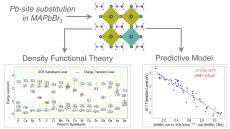Machine-Learned Impurity Prediction in Semiconductors

Impurities at the Pbsite were modeled in a hybrid perovskite material, Methylammonium Lead Bromide, and highthroughput DFT computations were launched on NERSC to calculate their formation enthalpies and energy levels. The computed DFT data has been shown for period IV substituents, and a machine learned model has been shown for one impurity level.
Scientific Achievement
Argonne National Laboratory researchers ran high-throughput simulations on NERSC supercomputers and generated comprehensive datasets of impurity properties in two classes of semiconductors: lead-based hybrid perovskites and cadmium-based chalcogenides. These datasets led to machine learned models that enable accelerated prediction and design for the entire chemical space of materials and impurities in these semiconductor classes.
Significance and Impact
Impurity energy levels in semiconductors can change their behavior in ways that have important consequences for solar cell applications. The ability to instantly and accurately estimate such impurity levels is paramount. The current research combines simulation and machine learning to generate results that can potentially transform the design of novel semiconductors that are defect-tolerant or have tailored impurity properties.
Research Details
The researchers performed density functional theory calculations for hundreds of impurity atoms in selected semiconductors to determine their formation enthalpies and energy levels. The results were transformed into predictive models using machine learning algorithms. The DFT simulations modeled systems containing ~ 100 atoms, using ~ 1.5 million CPU hours.
Related Links
- Mannodi-Kanakkithodi et al., ”Comprehensive Computational Study of Partial Lead Substitution in Methylammonium Lead Bromide", accepted, Chem. Mater. doi: 10.1021/acs.chemmater.8b04017 (2019).
- D.H. Cao et al., “Charge Transfer Dynamics of Phase Segregated Halide Perovskite mixtures", ACS Appl. Mater. Interfaces, 11 (9), pp 9583–9593 (2019).
About NERSC and Berkeley Lab
The National Energy Research Scientific Computing Center (NERSC) is a U.S. Department of Energy Office of Science User Facility that serves as the primary high performance computing center for scientific research sponsored by the Office of Science. Located at Lawrence Berkeley National Laboratory, NERSC serves almost 10,000 scientists at national laboratories and universities researching a wide range of problems in climate, fusion energy, materials science, physics, chemistry, computational biology, and other disciplines. Berkeley Lab is a DOE national laboratory located in Berkeley, California. It conducts unclassified scientific research and is managed by the University of California for the U.S. Department of Energy. »Learn more about computing sciences at Berkeley Lab.







